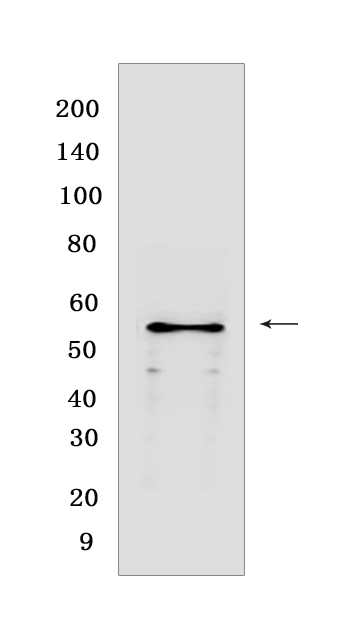Chk1 Rabbit mAb [14OX]Cat NO.: A60690
Western blot(SDS PAGE) analysis of extracts from HeLa cells.Using Chk1Rabbit mAb [14OX] at dilution of 1:1000 incubated at 4℃ over night.
Product information
Protein names :CHEK1,CHK1,CHK1_HUMAN,Serine/threonine-protein kinase Chk1
UniProtID :O14757
MASS(da) :54,434
MW(kDa) :54 kDa
Form :Liquid
Purification :Protein A purification
Host :Rabbit
Isotype :IgG
sensitivity :Endogenous
Reactivity :Human
- ApplicationDilution
- 免疫印迹(WB)1:1000-2000
- 免疫组化(IHC)1:100
- 免疫荧光(ICC/IF) 1:100
- The optimal dilutions should be determined by the end user
Specificity :Antibody is produced by immunizing animals with a synthetic peptide at the sequence of human Chk1
Storage :Antibody store in 10 mM PBS, 0.5mg/ml BSA, 50% glycerol. Shipped at 4°C. Store at-20°C or -80°C. Products are valid for one natural year of receipt.Avoid repeated freeze / thaw cycles.
WB Positive detected :HeLa cells
Function : Serine/threonine-protein kinase which is required for checkpoint-mediated cell cycle arrest and activation of DNA repair in response to the presence of DNA damage or unreplicated DNA (PubMed:11535615, PubMed:12446774, PubMed:12399544, PubMed:14559997, PubMed:14988723, PubMed:15311285, PubMed:15665856, PubMed:15650047, PubMed:32357935). May also negatively regulate cell cycle progression during unperturbed cell cycles (PubMed:11535615, PubMed:12446774, PubMed:12399544, PubMed:14559997, PubMed:14988723, PubMed:15311285, PubMed:15665856, PubMed:15650047). This regulation is achieved by a number of mechanisms that together help to preserve the integrity of the genome (PubMed:11535615, PubMed:12446774, PubMed:12399544, PubMed:14559997, PubMed:14988723, PubMed:15311285, PubMed:15665856, PubMed:15650047). Recognizes the substrate consensus sequence [R-X-X-S/T] (PubMed:11535615, PubMed:12446774, PubMed:12399544, PubMed:14559997, PubMed:14988723, PubMed:15311285, PubMed:15665856, PubMed:15650047). Binds to and phosphorylates CDC25A, CDC25B and CDC25C (PubMed:9278511, PubMed:12676583, PubMed:14681206, PubMed:12676925, PubMed:12759351, PubMed:19734889, PubMed:14559997). Phosphorylation of CDC25A at 'Ser-178' and 'Thr-507' and phosphorylation of CDC25C at 'Ser-216' creates binding sites for 14-3-3 proteins which inhibit CDC25A and CDC25C (PubMed:9278511). Phosphorylation of CDC25A at 'Ser-76', 'Ser-124', 'Ser-178', 'Ser-279' and 'Ser-293' promotes proteolysis of CDC25A (PubMed:9278511, PubMed:12676583, PubMed:14681206, PubMed:12676925, PubMed:12759351, PubMed:19734889). Phosphorylation of CDC25A at 'Ser-76' primes the protein for subsequent phosphorylation at 'Ser-79', 'Ser-82' and 'Ser-88' by NEK11, which is required for polyubiquitination and degradation of CDCD25A (PubMed:9278511, PubMed:19734889, PubMed:20090422). Inhibition of CDC25 leads to increased inhibitory tyrosine phosphorylation of CDK-cyclin complexes and blocks cell cycle progression (PubMed:9278511). Also phosphorylates NEK6 (PubMed:18728393). Binds to and phosphorylates RAD51 at 'Thr-309', which promotes the release of RAD51 from BRCA2 and enhances the association of RAD51 with chromatin, thereby promoting DNA repair by homologous recombination (PubMed:15665856). Phosphorylates multiple sites within the C-terminus of TP53, which promotes activation of TP53 by acetylation and promotes cell cycle arrest and suppression of cellular proliferation (PubMed:10673501, PubMed:15659650, PubMed:16511572). Also promotes repair of DNA cross-links through phosphorylation of FANCE (PubMed:17296736). Binds to and phosphorylates TLK1 at 'Ser-743', which prevents the TLK1-dependent phosphorylation of the chromatin assembly factor ASF1A (PubMed:12660173, PubMed:12955071). This may enhance chromatin assembly both in the presence or absence of DNA damage (PubMed:12660173, PubMed:12955071). May also play a role in replication fork maintenance through regulation of PCNA (PubMed:18451105). May regulate the transcription of genes that regulate cell-cycle progression through the phosphorylation of histones (By similarity). Phosphorylates histone H3.1 (to form H3T11ph), which leads to epigenetic inhibition of a subset of genes (By similarity). May also phosphorylate RB1 to promote its interaction with the E2F family of transcription factors and subsequent cell cycle arrest (PubMed:17380128). Phosphorylates SPRTN, promoting SPRTN recruitment to chromatin (PubMed:31316063). Reduces replication stress and activates the G2/M checkpoint, by phosphorylating and inactivating PABIR1/FAM122A and promoting the serine/threonine-protein phosphatase 2A-mediated dephosphorylation and stabilization of WEE1 levels and activity (PubMed:33108758).., [Isoform 2]: Endogenous repressor of isoform 1, interacts with, and antagonizes CHK1 to promote the S to G2/M phase transition..
Tissue specificity :Expressed ubiquitously with the most abundant expression in thymus, testis, small intestine and colon..
Subcellular locationi :Nucleus. Chromosome. Cytoplasm. Cytoplasm, cytoskeleton, microtubule organizing center, centrosome.
IMPORTANT: For western blots, incubate membrane with diluted primary antibody in 1% w/v BSA, 1X TBST at 4°C overnight.


